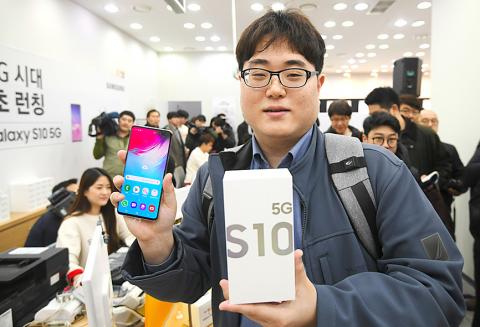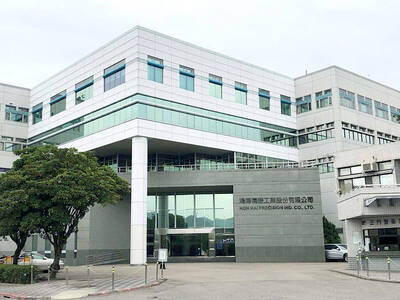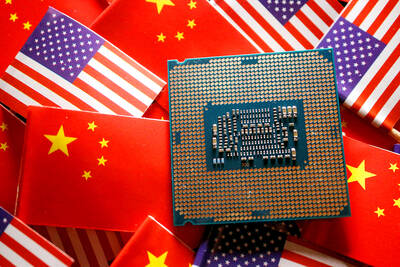The world’s biggest smartphone and memorychip maker Samsung Electronics Co yesterday warned of a more than 60 percent plunge in first-quarter operating profit in the face of weakening markets.
Operating profit for the first quarter would be “approximately 6.2 trillion won [US$5.45 billion],” the firm said in a statement, down 60.4 percent year-on-year.
Sales were about 52 trillion won, it said, marking a 14 percent drop.

Photo: AFP
The firm has enjoyed record profits in recent years, despite a series of setbacks, including a humiliating recall and the jailing of its de facto boss, but now the picture has changed, with chip prices falling as global supply increases and demand weakens.
The company’s earnings estimate was below analyst forecasts of 6.9 trillion won, according to Bloomberg News.
It would represent the firm’s lowest operating profit since the third quarter of 2016 and it comes after the firm reported its first fall in quarterly profit for two years in January.
Samsung shares yesterday closed down 0.2 percent in Seoul.
The company has to contend with increasingly tough competition in the smartphone market from Chinese rivals such as Huawei Technologies Co (華為) — which in 2017 surpassed Apple Inc to take second place — offering quality devices at lower prices.
Samsung supplies components to other manufacturers such as Apple as well as making its own devices, but market prices for LCDs have fallen 10 percent quarter-on-quarter, said Sanjeev Rana, an analyst at investment firm CLSA Ltd, while demand for smartphones in China — the world’s biggest market — has been weak.
Prices for NAND memory — used in smartphones and other devices — fell 20 percent in the first quarter, according to market tracker DRAMeXchange, which pointed the finger at consumers taking longer to replace their smartphones and lower-than-expected sales of Apple’s new devices.
DRAM chips, used in computer servers, fell by similar levels, it added.
Rana predicted a “slight” rebound in the second quarter.
“This quarter is the bottom in terms of earnings,” Rana said.
Samsung was yesterday launching the 5G version of its top-end Galaxy S10 smartphone — the first such device available anywhere — after South Korea this week won the global race to commercially launch the world’s first nationwide 5G networks.
South Korea’s three telecoms — SK Telecom, KT and LG Uplus — held launch events across Seoul for the Galaxy S10, whose base version costs 1.39 million won.
Before yesterday’s debut of the Samsung phone, 5G services had been restricted to a handful of specially selected users in South Korea.
Rival manufacturer LG Electronics Co is due to launch its V50 ThinQ, another 5G phone, later this month, while in the US, Verizon Communications Inc’s network works with Lenovo Group Ltd’s (聯想) Moto Z3 smartphone fitted with a special accessory.
Commercializing 5G gives South Korea the chance to build around the technology, which is crucial for the future development of devices such as autonomous vehicles and the Internet of Things.
It is expected to bring about US$565 billion in global economic benefits by 2034, according to the London-based Global System for Mobile Communications, an industry alliance.

Shares in Taiwan closed at a new high yesterday, the first trading day of the new year, as contract chipmaker Taiwan Semiconductor Manufacturing Co (TSMC, 台積電) continued to break records amid an artificial intelligence (AI) boom, dealers said. The TAIEX closed up 386.21 points, or 1.33 percent, at 29,349.81, with turnover totaling NT$648.844 billion (US$20.65 billion). “Judging from a stronger Taiwan dollar against the US dollar, I think foreign institutional investors returned from the holidays and brought funds into the local market,” Concord Securities Co (康和證券) analyst Kerry Huang (黃志祺) said. “Foreign investors just rebuilt their positions with TSMC as their top target,

REVENUE PERFORMANCE: Cloud and network products, and electronic components saw strong increases, while smart consumer electronics and computing products fell Hon Hai Precision Industry Co (鴻海精密) yesterday posted 26.51 percent quarterly growth in revenue for last quarter to NT$2.6 trillion (US$82.44 billion), the strongest on record for the period and above expectations, but the company forecast a slight revenue dip this quarter due to seasonal factors. On an annual basis, revenue last quarter grew 22.07 percent, the company said. Analysts on average estimated about NT$2.4 trillion increase. Hon Hai, which assembles servers for Nvidia Corp and iPhones for Apple Inc, is expanding its capacity in the US, adding artificial intelligence (AI) server production in Wisconsin and Texas, where it operates established campuses. This

US President Donald Trump on Friday blocked US photonics firm HieFo Corp’s US$3 million acquisition of assets in New Jersey-based aerospace and defense specialist Emcore Corp, citing national security and China-related concerns. In an order released by the White House, Trump said HieFo was “controlled by a citizen of the People’s Republic of China” and that its 2024 acquisition of Emcore’s businesses led the US president to believe that it might “take action that threatens to impair the national security of the United States.” The order did not name the person or detail Trump’s concerns. “The Transaction is hereby prohibited,”

Garment maker Makalot Industrial Co (聚陽) yesterday reported lower-than-expected fourth-quarter revenue of NT$7.93 billion (US$251.44 million), down 9.48 percent from NT$8.76 billion a year earlier. On a quarterly basis, revenue fell 10.83 percent from NT$8.89 billion, company data showed. The figure was also lower than market expectations of NT$8.05 billion, according to data compiled by Yuanta Securities Investment and Consulting Co (元大投顧), which had projected NT$8.22 billion. Makalot’s revenue this quarter would likely increase by a mid-teens percentage as the industry is entering its high season, Yuanta said. Overall, Makalot’s revenue last year totaled NT$34.43 billion, down 3.08 percent from its record NT$35.52